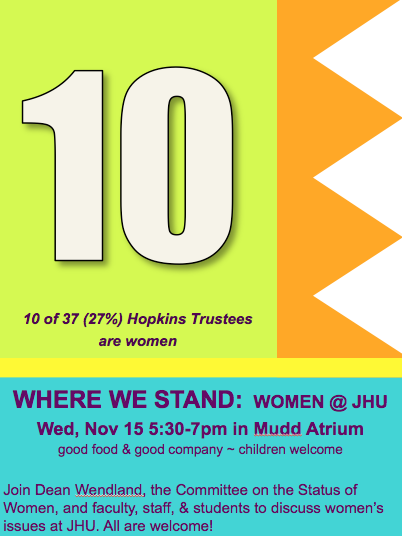
All posts by Anne-Elizabeth Brodsky
Sexual Harassment at Work
Over the week the New York Times published an overview of sexual harassment in the work setting–definitions of harassment and options for recourse. I am still trying to figure out why it’s in the Style section. . . . In any case, the link to the article is below, as well as the link to JHU’s OIE website on harassment and discrimination.
Valeriya Safronova, “When You Experience Sexual Harassment at Work” (NYT 11/10/17)
JHU Office of Institutional Equity: Harassment and Discrimination
And don’t forget . . . Please come by for good food and good company this Wednesday, Nov 15, 5:30-7pm at Mudd Atrium for “Where We Stand: Women @ Hopkins.” Hope to see you there! Kids welcome.
Gender Pay Gap in Physics
From “The Gender Pay Gap in Physics Persists” b :
Once factors such as postdoctoral experience and age are accounted for, the gap between the salaries of men and women is, on average, 6 percent, according to a survey conducted by the Statistical Research Center at the American Institute of Physics. Before accounting for such factors, the data showed that men in physics earned, on average, 18 percent more than women. The survey was based on the experiences of people who had earned their doctorates in physics in the United States in 1996, 1997, 2000, or 2001 and who were working in the country in 2011.
Two key reasons for the disparity: Women aren’t aggressive enough during initial salary negotiations, and they are less likely to ask for a raise, the article says. Men are also overrepresented in physics, and that feeds an implicit bias that benefits men. As a senior researcher quoted anonymously in the article said, “Boys in the department give money to boys in the department.”
Nancy H. Hopkins, a renowned champion of gender equity in science, told the magazine that closing the pay gap would be a likely result of an increase in the number of senior women faculty members serving in positions of power — such as on hiring, promotion, and editorial boards. Ms. Hopkins, a molecular biologist and now a professor emerita at the Massachusetts Institute of Technology, sparked an examination of gender equity for women scientists at MIT and beyond decades ago. She measured things like her smaller laboratory space and lesser funding, and made the argument that her treatment amounted to discrimination. MIT subsequently released its own report acknowledging that female scientists were indeed discriminated against.
Welcome to Vesla Weaver, leading scholar on racial politics and criminal justice issues in America
We welcome Bloomberg Distinguished Professor Vesla Weaver to JHU!
“We cannot understand modern inequality or begin to move past the harms of incarceration and surveillance without understanding that punitive action is threaded through a multiplicity of activities and agencies in poor communities,” Weaver says.
Read about Vesla’s work on the Portals for Research project at Lexington Market here.
Emily Wilson, the Odyssey, and “the human cost of differences of mind”
. . . “Throughout her translation of the ‘Odyssey,’ Wilson has made small but, it turns out, radical changes to the way many key scenes of the epic are presented — ‘radical’ in that, in 400 years of versions of the poem, no translator has made the kinds of alterations Wilson has, changes that go to truing a text that, as she says, has through translation accumulated distortions that affect the way even scholars who read Greek discuss the original. These changes seem, at each turn, to ask us to appreciate the gravity of the events that are unfolding, the human cost of differences of mind.”
Wyatt Mason, “The First Woman to Translate the Odyssey into English” (NYT Magazine 11/2/2017